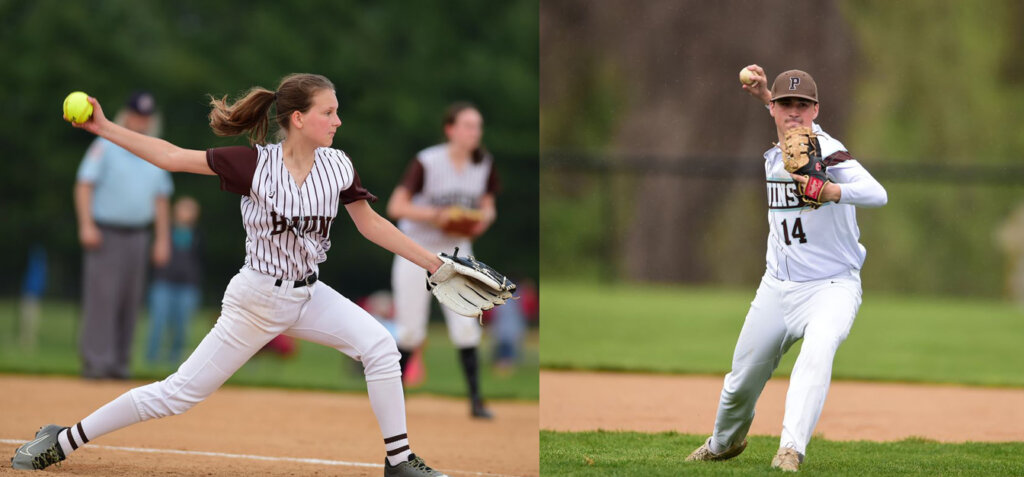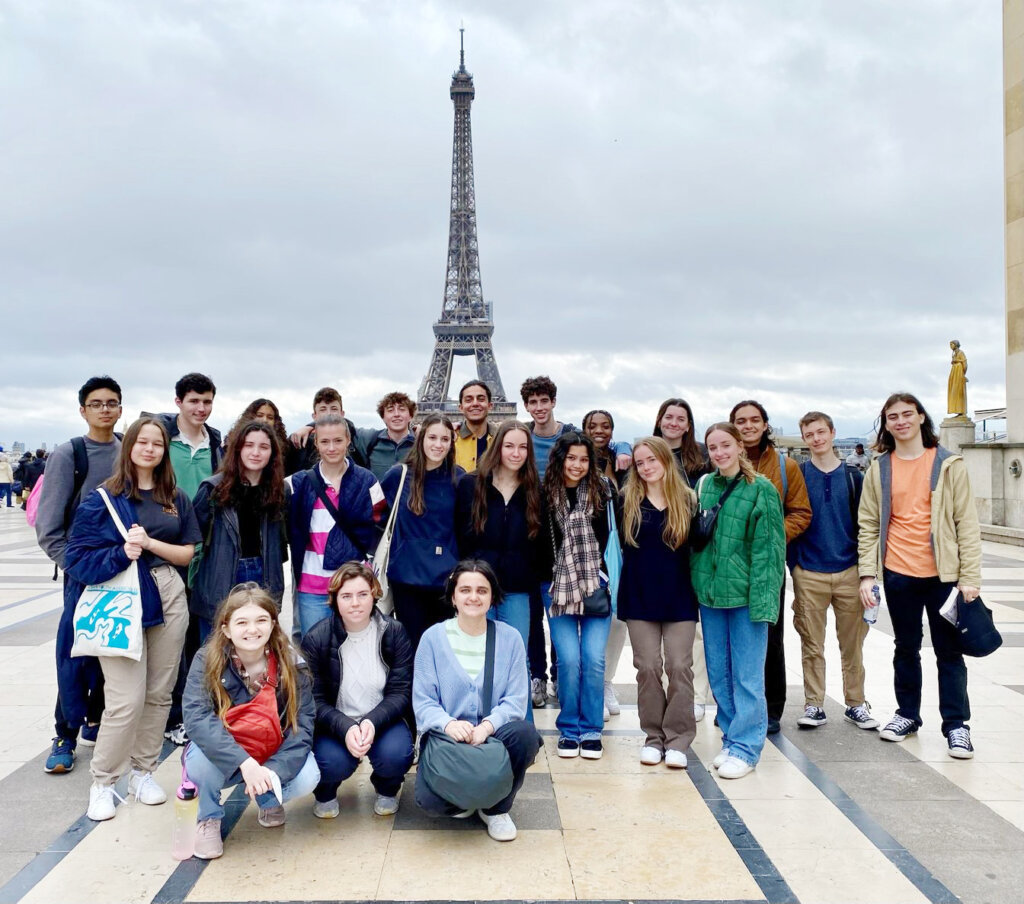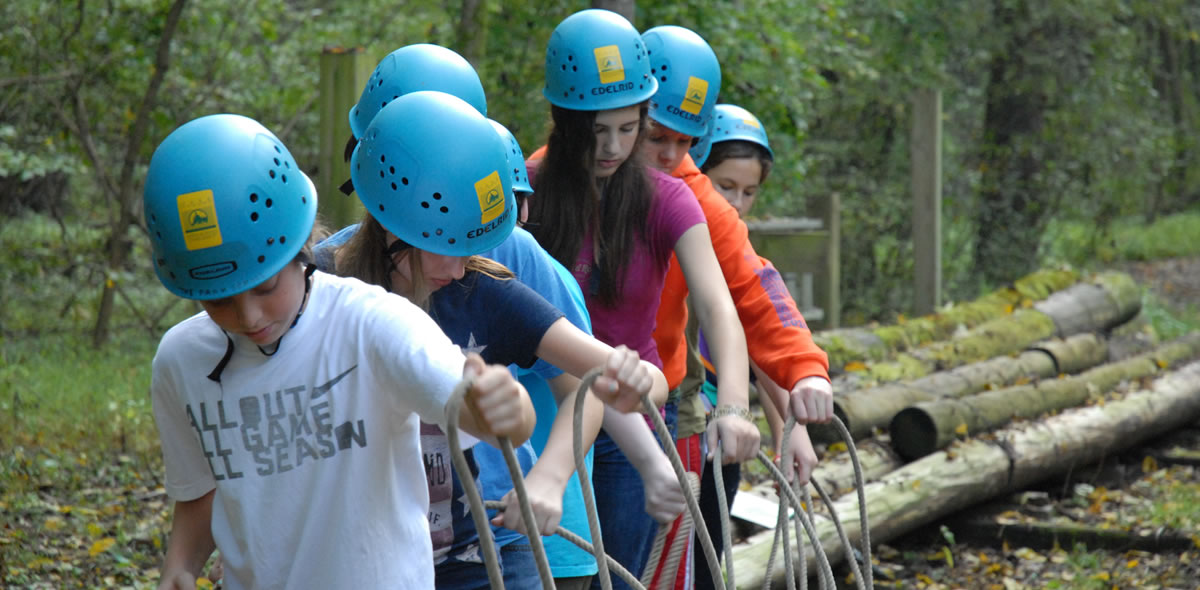English
The English department teaches literature and writing offering a curriculum that encompasses a wide variety of literary genres, periods, themes, and voices.
In selecting courses, students are encouraged to build a program that reflects this variety. Students should also aim to take classes with different English faculty members, for each teacher brings to the classroom a distinctive style and different fields of expertise. Writing and discussion are central components of all English courses.
Requirements
The Upper School English department requires eight consecutive semesters of English, including English 9 and English 10.- Sophomores who wish to double in English first semester must seek departmental permission before they do so.
ENGLISH 9
Grade 9 • Required
This course introduces students to various literary genres and modes of writing, and prepares them with the reading, writing, and discussion skills that they will need to thrive in our student-centered program. Structured analysis of selected texts is emphasized through close reading, annotation, and formal and informal writing assignments that include creative nonfiction, fiction, and analytical writing. Students experiment with the structural and rhetorical elements of various genres, and further their understanding of the writing process, particularly as applied to the literary essay, through revising in response to critiques from instructors and students. Texts may include a Shakespeare play, a contemporary play, a novel, and anthologies of poetry and short stories.
Grade 10 English Classes • Required
In the fall term, all tenth graders are required to enroll in one of the sections of English 10. These courses are organized by theme, but each focuses on the writing process — brainstorming, drafting, getting feedback, revising — and on the rhetorical modes of description, narrative, comparison/contrast, analysis, and definition.
English 10: Writing About Coming of Age
“Coming of age” is a phrase that stands for growing up, developing, or maturing. These narratives are stories that deal with the experience of growing up. But what does growing up or development even mean when we are talking about human beings? Is this a linear progression toward a finish line, or more of a messy becoming? How does a person’s identity, background, or environment impact this process? In this course, students will explore these questions and many more while they encounter coming-of-age narratives found in graphic novels, short stories, poems, and films. Students will write about these narratives and also create their own coming-of-age stories. Writing assignments could include a personal narrative, an analytical essay, and an article. .
English 10: Writing About Film
Students look comparatively and historically at various aspects of filmmaking, experiment with ways of describing films and moving images, and see what the art of filmmaking has to teach them about the art of writing. They read broadly in both historical and contemporary film criticism and review. Writing assignments include essays, short descriptions, appreciations, and a fragment of a screenplay.
English 10: Writing About Ideas
Should bodies of water have legal rights? Are corporations people? Is AI a tool or an ideology? What defines personhood—and who gets to decide? Is democracy worth defending? This course is an introduction to contemporary public philosophy and analytical writing. No previous experience with philosophical questions, methods, or readings is required. Through close reading and developmental writing exercises, students will engage with themes like environmental ethics, artificial intelligence, democracy, citizenship, identity, freedom, and justice. By the end of the course, students should feel more confident writing about pressing ideas to different audiences, situations, and contexts.
American Woman: Representations of Women in American Literature and Culture
Grades: 11-12
In this course, students will analyze representations of women in American literature and culture. They will primarily study representations of women in literature, but will also look to film, television, visual art, music, and pop culture to provide additional depth and variety to their examination. The characters and creators in this course will reflect the diversity of women in America. The course will allow a space in which to discuss the challenges and triumphs of being a woman in America, and the way representations impact the experience and expectations of womanhood. Assignments will include regular readings and short writing assignments, as well as a creative project and a final paper.
At Home in the World
Grades: 11-12
In this course, students will explore cosmopolitanism in literature and films in the 21st century. Thinkers and writers of this tradition invite readers to consider how the complicated condition of “being at home in the world” helps them and the class interrogate facile notions of national identity and its thorny political and cultural entanglements. The work in the course will be to carefully weigh ideas of displacement, migration, cultural disappearance, and genealogies of abuse of power against the possibility of generating new narrative models and analytical tools in the service of a more critical global perspective. This course requires close reading, robust discussion, active listening, and commitment to our collective learning.
Canons: Anglo-American Literature
Grades: 11-12
Is there such a thing as an Anglo-American tradition in letters? What concerns do British and American literature share, and how do the traditions differ? In this course, students will examine the literatures of two nations divided by a common language. They will consider works that comprise part of a traditional canon of British and American literature (by writers such as William Shakespeare and Emily Dickinson) as well as more recent literature that converses with and sometimes against that canon (by writers such as Zadie Smith and Chang-Rae Lee). This is a survey course aiming to cover a wide range of genres, subject matter, and styles.
Etymology and Semantics
Grades: 11-12
Etymology is the investigation of word origins; semantics examines how words mean what they do. Students study Latin and Greek bases, learn to tell the stories of particularly interesting words, investigate the history of English from its Germanic origins to its current status as a lingua franca, and write an essay or two. Please note: there is no way to study etymology without memorizing a lot of roots and affixes. If students do not like this sort of work and don’t like being tested on their grasp of details, they should not take this course.
Indigenous American Literature
Grades: 11-12
In this course, students will look both at contemporary Indigenous American literature (novels, memoirs, and poetry) and at traditional oral literature (including folktales, origin stories, and ritual), to try to experience these stories both as readers and as fellow human travelers who seek to learn from cultures that live where they live. As students enjoy these works for their own merits, they will also be looking to them for an understanding of Native American politics and cultural identity, religion and folklore, ideas about personal identity and power, and views of the earth and the environment.
Link of Chain: Tracking Influence in American Literature
Grades: 11-12
This class aims to study a single strand of influence within American literature. Beginning with the work of Ralph Waldo Emerson, and proceeding to the contemporary moment, the curriculum will feature a sequence of novels, stories, poems, essays, speeches, and philosophical treatises that collectively helped to establish an indelible American grain. The focus will be the manner in which each text somehow inspired or compelled the next. Students will pursue the fundamental question of whether every author participates in and belongs to a great, inescapable current of thought, and to what extent that membership represents a burden or an opportunity. Finally, students will ask how important it is that they recognize, or submit to, the vast field of influence that shapes their own artistic endeavors.
Literature of Loss: Grief and Grievance
Grades: 11-12
Introducing her translation of plays by Euripides, Anne Carson writes, “Why does tragedy exist? Because you are full of rage. Why are you full of rage? Because you are full of grief.” This course will explore the relationship between loss, grief, and resentment in works of memoir, poetry, drama, and fiction. As students analyze works of literature, the class may take up the following questions: Is grief an emotion or a state of being? Is it solely psychological or does it have political implications? Is it possible to grieve well? Why is there pleasure in reading artistic responses to loss? Is there transformative potential in the rage that grief unleashes, or does it inevitably curdle into complaint and inaction? Possible writers include Joan Didion, William Shakespeare, Edwidge Danticat, Thomas Hardy, Natasha Tretheway, Sophocles, Richard Wright, and Yōko Ogawa.
Literature of the Civil Rights Movement
Grades 11-1
How does literature, music, and art propel a movement? In this course, students will be looking at the modern Civil Rights movement through the lens of literature. What writing helped to ignite the movement? How did writers and artists respond to the struggle for racial justice? How does literature exist as protest? Required reading may include works by Ralph Ellison, James Baldwin, Alice Walker, and Dr. Martin Luther King, Jr. Students should be prepared to not only write analytical and creative assignments, but also to practice their public speaking skills.
Music and Migration: History and Literature of American Roots Music
Grades 11-12 • This course can be taken for either English or History credit.
There are more differences between us than we can readily understand; there are also more similarities and connections, both historically and in our art. In this course, students will explore departures and continuities across three routes of traditional American migration. Seeking an understanding of the blues, jazz, bluegrass, and country music, they’ll ‘travel’ from the Mississippi Delta to Chicago, from Appalachia to the Mid-Atlantic megalopolis, and from Oklahoma to Bakersfield, California. Course texts may include Billie Holiday’s Lady Sings the Blues, Michael Ondaadtje’s Coming through Slaughter, and John Steinbecks’ Grapes of Wrath, as well as contemporary documents including the many songs that students will hear together.
Psychology of Power Through Shakespeare’s Henriad
Grades 11-12
In this course, students will read and watch Shakespeare’s Henriad: Richard II, Henry IV Parts 1 & 2, and Henry V. These works are some of Shakespeare’s best-known histories, and they are linked by transfer of the crown. Students will examine and analyze overarching questions around how Shakespeare shares the human emotional response to power. They will also analyze how these plays treat the issue of women and agency. These works include Falstaff, Shakespeare’s greatest comic character, and Hal, a young man pulled between two very different lifestyles. These two characters provide great fodder for comparing and contrasting. The class will consider other big questions too. Does privilege come with a price of obligation? What is the value, as well as the cost, of patriotic rhetoric? Writing assignments will include analysis and creative pieces.
Shakespeare: From Page to Stage
Grades 11-12
In this course, students will do a deep dive on Henry IV, Parts 1 and 2 in preparation for the Spring Production. The class will start with a study of Shakespeare’s sonnets, to build comfort approaching Shakespeare’s language. Closely reading the play, students will take it line by line, mastering comprehension, teasing out deeper meanings, reading critical interpretations, analyzing character motivation, experimenting with delivery, and imagining production elements. Together, students will build a sense of the world of the play, which they will bring to life in the spring. Students who have been cast in the play are required to take this course, but the elective is open to anyone who is interested in the delights of Shakespeare’s language.
Writing Practicum
Grades: 11-12 • After completing the course, students will serve for the rest of their Park careers as tutors in The Michael Cardin ’85 Writing Center. Preference will be given to juniors; limited seats will be held for seniors.
This is an intensive writing workshop that is also about the teaching of writing. Students will write and revise creative nonfiction. In recent years, assignments have included a best earth memory, description of a real or imagined photograph, favorite song analysis, philosophical meditation, and college essay – as well as stories, poems, and AP exam responses. The focus throughout will be on the process of writing, and students will learn – through reading, discussion, role-playing, and lots of practice – the techniques of effective peer tutoring. They will tutor writers from the Lower, Middle, and Upper School.
Writing Workshop: Short Fiction
Grades: 10-12
This class centers on the workshop experience, in which each student composes and shares a short story that corresponds to a focal point of the craft (dramatic action, setting, characterization, tone, perspective, dialogue, time management, psychological distance, the unreliable narrator, the extension of metaphor, and the delivery of statement are among the elements that we will explore). Students will read a selection of short stories to bolster their grasp of each unit of study and must be energetic about critiquing one another’s written work.
Anna, Alice, Akashi: Anna Karenina, Alice in Wonderland, and the Tale of Genji
Grades: 10-12
In this class, students will read three wonderful classic novels. Murasaki Shikibu’s The Tale of Genji, Lewis Carroll’s Alice in Wonderland, and Through the Looking-Glass, and Leo Tolstoy’s Anna Karenina range widely across history and cultures, and present the worlds of their times quite fully. They are about how people live — and among other things they are about women working to outwit expectations in order to live their lives, to live as themselves and to live out their own objectives — against the prevailing manners and powers. In this class, writing will include imitations, short reflections, critical responses, and personal essays.
Art of the Essay
Grades: 10-12
In this course, students will work toward a deeper understanding of the essay — its history, its elegance, and its inner workings. If the essay represents the mind in motion, then students will seek to harness that motion and shape it into clear, eloquent, and insightful pieces of writing. To do so, they will study the work of published essayists, write essays of their own, and discuss these works in a workshop setting. Forms covered may include narrative, meditative, and lyric essays.
Digital and Electronic Literature
Grades: 10-12
Is a computer programmer a storyteller? Can computers help us craft new literary genres? What is a born digital text? In what ways has digital literature challenged us to rethink the structuring of language, culture, and knowledge itself? This course will help students develop a critical awareness of contemporary digital literature. Students will have the opportunity to learn about literary computational methods, analyze new forms of textuality, apply traditional close reading practices to multimodal narratives, and write their own digital texts. They will pay close attention to writers from the Global South as these authors try to reimagine the landscape of digital storytelling.
Downtown Scene: Literature and Art in New York in the 70s and 80s
Grades: 10-12
In this course, students will enter the world of downtown New York in the 70s and 80s to be among a world of diverse artists pushing against capitalism to make art on their own terms. The class will study the work of poets, writers, artists, and filmmakers who tried to capture real-life depictions of New York’s underbelly through guerrilla journalism, handmade zines and fliers, alternative music and neo-expressionist art. Assignments may include Basquiat-like visual art, Warhol-like installations, Eileen Myles-like poetry, Spalding Gray-like monologues, and Velvet Underground-like music.
Homeric Epic
Grades: 10-12
The first half of this course will be devoted to reading Homer’s Iliad, which tells the story of the Trojan War, focusing on the great hero Achilles and the decision he must make between a heroic short life and a long life devoid of glory. After reading The Iliad, the class will turn its attention to The Odyssey, Homer’s epic about the ultimate survivor, Odysseus, and the complexity of his resilience. Discussion will be conducted primarily in the seminar format, so class participation will be an essential aspect of the class. There will be opportunities to write in response to the readings in both creative and analytical forms.
How To Have An Opinion
Grades: 10-12
Have you ever disagreed with someone’s take on a movie but been unsure how to articulate your dissent? This course gives you the opportunity to practice and hone your skills at holding court, especially about works of art and culture. For the purposes of this course, the term “art” is capacious, including, but not limited to, literature, song, and film. What do we want from art, anyway? The class spends a couple of weeks attending to the history of art criticism (what did the ancient Greeks want from art? The modernists?) Then, students will work on developing their own criteria for judgment and train their critical faculties on a variety of artistic works. The class may read critics such as Horace, Hanif Abdurraqib, and Jia Tolentino, and may consider works of art by Shakespeare, Kendrick Lamar, and Mira Nair. Students will also have the opportunity to select their own objects to critique.
LGBTQ+ Literature
Grades: 10-12
In this course, students will focus on LGBTQ2IAP+ writers, texts, and issues of the past and present. They will read fiction, poetry, and plays that represent some of the experiences, challenges, and joys of being LGBTQ2IAP+. A major focus of this course is critical reading: the ability to not only understand what the text says, but also interpret what the text does on a deeper level. This course will include short daily writing assignments, a creative project, and a literary analysis paper.
Literature at The End of The World
Grades: 10-12
War, famine, global pandemics, catastrophic natural disasters…zombies. For as long as humans have told stories, we have imagined and spun yarns of the end of the world as we know it. Some stories have served as cautionary tales, while others have been used as commentary to reflect upon the realities of a given time and culture. In this course we will explore a range of apocalyptic stories. In this course, students will consider the ways the end of the world has been portrayed in novels, short stories, essays, and religious texts, as well as in popular film and television. Course work will include analytical essays, journal entries, group presentations, student-led discussions and creative writing—including an opportunity for students to craft their own original apocalyptic tale.
Poems and Lives
Grades: 10-12
It seems clear that there is a relationship between writing and living, but what is it? For starters, do we merely write what we live, or do we also live what we read and live differently because of how we write? And as people seeking to understand books and writers, how literally are we to take what we read about a poet’s life? In this course, students will ask these sorts of questions as they discuss, write about, and imitate the works and lives of writers from very different times and places: from the archaic Greece of Sappho to Basho’s 17th-C Japan, to John Keats’ early 19th-C England to Sylvia Plath’s and Ted Hughes’ version of the 20th C, to Ada Limón’s, and to WB Yeats’ critiques of 20th-C structures of power.
Poetry Writing
Grades: 10-12
In this class, students will allow every poem to be an experiment. They will play with language, attention, emotion, interaction, and structure — always asking, What kind of poem will this kind of play make? What kind of poem comes from sitting in stillness? What kind of poem comes from spontaneity? What kind of poem comes from confession? What kind of poem comes from collaboration? What kind of poem comes from following a strict form? What kind of poem comes from thinking of language as paint we spread on a piece of paper? Though students will engage in regular workshopping, the question will never be “How good is this poem?” Instead, students will train themselves to ask, “What kind of poem do we have here? How can it become more itself?”
Proceed with Caution: Horror Stories
Grades: 10-12
Warning: The literature in this course contains frightening situations, blood-sucking villains, haunted mansions, uncanny valleys, and monsters of the fantastical and everyday variety. Students will travel through the dark, mysterious corridors of scary stories seeking to uncover what they fear most, and examining how writers throughout literary history have tapped into their deepest fears. The class will explore multiple sub-genres, like mystery, macabre, thriller, apocalyptic, and true crime. There will be regular short writing assignments, a creative project, and an analysis paper at the end of the semester.
Psychology and Literature
Grades: 10-12
“Character is destiny” —Heraclitus
“Character is plot” —F. Scott Fitzgerald
If character is destiny, or at least plot, what is character? To answer that question, students in this class will explore theories touching on four psychological domains: dispositional, intrapsychic, socio-cultural, and adjustment. They will use their repertoire of theories to ask crucial questions about the characters they encounter: Why do they do what they do? How do their personalities determine their responses? What environmental or social factors may have affected the development of their personalities? And, of course, students will be asking these same questions about themselves.
The Afterlife in World Literature
Grades: 10-12
This class will explore how literature expresses beliefs about the afterlife for human beings. Does our narrative and poetic rendering of the afterlife suggest a faith, a hope, an expectation, or an uninhibited capacity for imagination that actually conveys our entire philosophy of existence? How do these depictions of the afterlife reveal what is most important about being alive in the first place, according to the individual authors and the values of their societies? Is there tension in the relationship between these depictions, or does a certain continuity prevail? The curriculum will span thousands of years, and include fiction and poetry from all over the world. This class involves a nightly commitment to reading and writing.
The Literature of Protest
Grades: 10-12
How do artists protest social and political conditions that concern them, and is such protest art or propaganda? Though students will largely be examining written works of literature, there may also be opportunities to consider music, visual art, and film. They will also read short works of criticism that attempt to define and evaluate political art. Finally, students will attempt to create their own artful protests. Potential texts include: Octavia Butler’s Parable of the Sower, Claire Vaye Watkins’ Gold Fame Citrus, excerpts from Ralph Ellison’s Invisible Man, Joan Didion’s Sentimental Journeys, James Baldwin’s Everybody’s Protest Novel, excerpts from Doris Lessing’s The Golden Notebook, and excerpts from Cathy Park Hong’s Minor Feelings.
Visual Studies: An Introduction to Our Way of Seeing
Grades: 10-12
How do static and moving images persuade, manipulate, or inspire us? This course introduces students to the study of visual culture. Their work will be to examine how images communicate, persuade, and shape their understanding of the world they inhabit. The class will analyze a wide range of visual texts—from literature, advertisement, film, art, and digital culture—through the interdisciplinary lens of rhetorical and cultural theory. By “reading” visual culture critically, students will become familiar with the mechanisms of visual narratives and their role in constructing social reality. Students will write short essays and create visual artifacts as part of their work in the course.
West Meets East
Grades: 10-12
In this course, students will examine the influence of Chinese literature on Western, especially American, literature. They will begin with an introduction to the rich tradition of Chinese literature from the past three millennia, then look at how Westerners—with little access to the language or the culture—first made sense of this very different tradition. Finally, the class will turn its attention to the work of contemporary scholar-poets who actually read and speak Chinese, especially the work of American-born Chinese and recently immigrated writers. Readings will include poetry and prose of Ezra Pound, Amy Lowell, Li-young Lee, and Gish Jen.
Writing Workshop: Long Fiction
Grades: 10-12
Like Writing Workshop: Short Fiction, this class centers on the workshop experience, in which students compose and share original narrative fiction for peer critique; however, this class emphasizes techniques to extend a story. Students will continue to study the principle elements of narrative craft, but they will focus centrally on structure. This course builds naturally off of the short fiction workshop class, but it does not require any previous experience in narrative writing. The curriculum will include stories ranging from thirty pages (such as work by Francisco Coloane and James Baldwin) to more expansive narratives of up to a hundred pages (such as work by Peter Taylor, Alice Munro, James Joyce, Jack Kerouac, Annie Ernaux, John Steinbeck, Jim Harrison, and Alan Sillitoe). Students in this class must be energetic about critiquing one another’s work.





